Unregulated LED bulbs
Recently it has become fashionable to use LED lamps ( LED , Light Emitting Diode). The main reasons are energy saving (increased light output with the same energy consumption), environmental friendliness (in production, harmful materials like mercury can be excluded). In terms of energy saving, LED lamps hit so much other types of lamps that some countries impose bans on the production and sale of traditional incandescent lamps used for home and office. Most likely, something similar will happen with time in Russia. The purpose of this review is to find out what LED lamps are, what parameters they have, and which lamps are best for home lighting.
I will not compare LED-lamps with other light sources, just try to compare some LED-lamps among themselves. The review also did not include lamps with built-in dimmers (regulators of the lamp brightness level) and lamps with a standard base, which can be screwed into the cartridge instead of a conventional light bulb (there are also such LED lamps). I wanted to explore some of the parameters of LED lamps on my own - electromagnetic interference and flickering of light (manufacturers do not provide any objective information of this kind). I hope that the review will be useful to those who are thinking about the use of LED lamps at home.
Obviously, the LED light bulbs must generate interference, because each is a pulse controller. The controller operates at frequencies of the order of 50..85 kHz, but due to sharp voltage drops at the key node of the controller, an electromagnetic signal with a wide spectrum is obtained. There is no specific information about the level of interference anywhere. In the instructions for the lamp, you can read abstract phrases such as “The product is certified according to current State Standards”. But what does this really mean? How much do these lamps generate noise, and how different are the different brands of lamps in this parameter? It is impossible to compare different lamps in terms of noise level without special experiments, so I decided to get puzzled by this too.
')
In addition, the LED has a very high speed, i.e. it turns on and off almost instantly. The current feeding the LEDs has pulsations due to the nature of the controller construction. For reasons of the cost of production, the filter for smoothing pulsations cannot be made ideal, therefore the LED-lamp will necessarily flicker. The smaller the pulsation of the luminous flux, and the higher the frequency of the pulsations, the subjectively better the LED lighting will be, the less tired the eyes will be. The intensity of flicker and its nature depends on the implementation of the controller. It also wants to explore.
[ What lamps are involved in the review ]
It was possible to purchase the lamps of the companies Ecola (Russia, Moscow), Navigator (LLC BT-Logistic, Russia, Moscow), BBK (BBK Electronics LTD., China), Jazzway (like a Russian company, but where it is located, could not be determined), Gauss (Russia, Naberezhnye Chelny), ASD (ASD Lighting, United Kingdom). All lamps had bases like GU5.3 and GU10, incompatible with traditional incandescent bases. The photo below shows these caps. The distance between the axes of the pins at the base of GU5.3 is 5.3 mm, for the GU10 it is 10 mm.
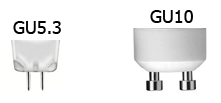
[ How was the light level measured ]
I have not had the opportunity to do all the measurements exactly as recommended by the standards [1]. Therefore, I tried to put the lamps in the same conditions: I twisted the tested lamp into a ceiling lamp with a lamp shade and measured the level of illumination at the workplace, where I sit at the computer. Illuminance measured lux meter Lux Meter LX1010BS .
118 lux - workplace lighting during the daytime with daylight ceiling lights turned off. 400..1000 lux - a sunny day in the shade, a well-lit workplace. In my tests, the illumination turned out to be about 60..100 lux - I wrapped the test lamp in the upper ceiling lamp and installed a luxmeter some distance from the lamp so that the main direct beam of light did not fall on it.
[ Comparison of lamps in terms of electromagnetic interference ]
I didn’t have a radio frequency spectrum analyzer, so I checked the hearing with the help of the Leningrad-006 radio receiver, on the HF and VHF bands.
The radio receiver stood with the whip antenna extended at a distance of 1 meter from the working lamp. Each lamp received a conditional estimate of the interference level from 0 to 10 (0 interference was not detected, 10 is the maximum interference level), and this data was entered in Table 2.
[ How the ripples of the light flux were evaluated ]
As a sensor of the pulsations of light, I used a solar battery from a country luminaire.
Loaded the battery on a 180 Ohm resistor and connected to the oscilloscope. As it turned out, it turned out to be an excellent light sensor, which confidently showed both low-frequency (100 Hz) and high-frequency pulsations (50..85 kHz). Interestingly, some lamps gave pulsations at a frequency of 100 Hz, and some at high frequencies of 50..85 kHz.
You still won't notice the pulsations of 100 Hz, but perhaps this will increase fatigue and you may experience visual beats with the TV screen (many modern TVs also have a screen refresh rate close to 100 Hz). High-frequency pulsations of light can affect the operation of remote control systems for household appliances. In addition, if a room is illuminated by several lamps with large pulsations of light at a high frequency, then due to the difference in the frequencies of the pulsations (the operating frequencies of the controllers are not synchronized with each other), light pulsations can also be seen by eye.
Thus, it is necessary to try to choose lamps with a minimum level of pulsation of the luminous flux, at whatever frequency they are.
[ As I compared the lamps to each other ]
First, I put into a single table all the official data that I was able to collect about the lamps - the price, power consumption, color temperature and other parameters that can be found on the lamp packaging. This table allows you to make a general preliminary assessment of the lamps. Green highlighted cells in the table, showing the best parameters among the other lamps, orange - bad parameters.
Table 1. Parameters of LED lamps provided by the manufacturer.
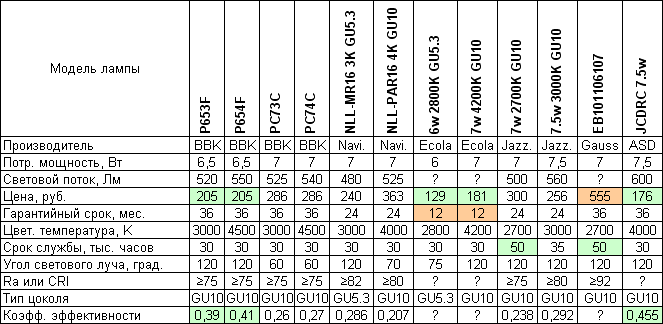
The most important parameters that can be distinguished in the table are the price of the lamp, the luminous flux and the power consumption. Their ratio determines how effective the lamp is. I did not take into account the service life, since it cannot be checked, and the actual service life will vary greatly depending on the operating conditions. To estimate the lamp's efficiency, I calculated the conditional efficiency coefficient K:
K = Light / (Price * Pow)
In this formula, Light means luminous flux (Lm, the higher the luminous flux, the brighter the lamp shines), Price is the price (rubles, the cheaper the lamp is, the faster it will pay for itself), Pow is the power consumed by the lamp (W, the smaller the lamp consumes electricity, so it is more profitable). This coefficient K rather conditionally estimates the efficiency of the lamp, because the luminous flux strongly depends on the presence of a reflector (the angle of the light beam), and many other factors are not taken into account (controller efficiency, lamp life, workmanship, etc.).
The second table was compiled on the basis of experimental data. The table includes the measured level of illumination, the level of radio interference, pulsations of the luminous flux and other data. Green highlighted cells in the table, showing the best parameters among the other lamps, orange - bad parameters.
Table 2. Experimentally obtained parameters of LED lamps.
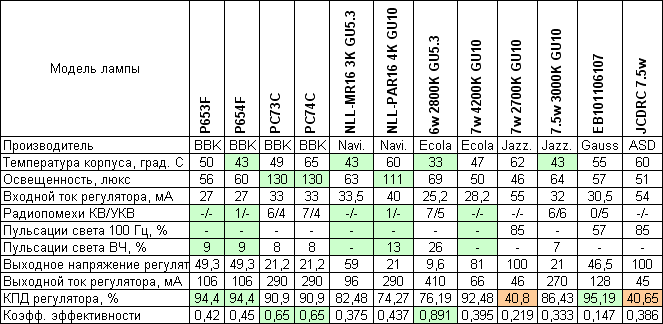
The line “Illumination” shows the illumination in suites, which the lux meter showed at my workplace (the lamp was installed in the ceiling lamp). Of course, for a full-fledged illumination of the whole room, a single 6.7 watt LED lamp is not enough.
The efficiency of the regulator was calculated by the traditional method:
Efficiency,% = 100 * (Pout / Pin)
This formula Pout means the output power delivered by the regulator (the product of the measured current and voltage), and Pin means the power supplied to the regulator input (the product of the measured input current and input voltage). Please note that some of the lamps in the review had a very low controller efficiency - about 40%, which seemed to me very strange. Subsequently, it turned out that for these lamps the “controller” is built according to the simplest scheme - based on a quenching capacitor (for more, see [4]). Not sure what to buy such lamps.
[ BBK ]
I was surprised when I learned about BBK as a lamp maker, because I had to deal with BBK appliances like DVD players or media centers before. 4 BBK lamps, which have fallen into the review, have a high-quality plinth chambered for GU10 in white heat-resistant plastic (looks like ceramic) and an aluminum radiator.
P653F and P654F lamps have a smaller power and consist of 32 separate LEDs placed on the same plane, at some distance from each other. Therefore, the P653F and P654F lamps produce more diffused light with a beam angle of 120 o .
The PC73C and PC74C lamps are equipped with a reflector concentrating light from a complex multi-segment LED (consisting of a 5x7 array of radiating elements), therefore they produce a narrow beam of light with a divergence angle of about 60o. The lamp radiator has a temperature of 45..65 oC.
BBK lamps look the best of all in terms of design and performance. BBK are not the only ones in the review who have an honest aluminum radiator, but BBK has a radiator of the highest quality and has many cooling lobes. The surface of the radiator has traces of processing on a turning and milling machine, and this is quite an expensive operation. I don’t know how the lamps were made, but this affected the consumer price only slightly (see Table 1).
The color temperature of the lamps, as far as I could figure out, depends on the color of the compound, which covers the light-emitting LED elements. The yellower the compound, the lower the color temperature.
The P653F and P654F lamp controllers are based on the SM7525 chip, while on the PC73C and PC74C lamps, based on the BP9023 chip [4]. In terms of radio interference, the PC73C and PC74C lamps did not perform well (see Table 2). P653F and P654F lamps have a small, almost imperceptible level of radio interference. The level of pulsation of the light flux of all BBK lamps is very low (about 8..9%) and lies in the high-frequency, invisible spectrum (about 55 kHz). Of these lamps, I would choose for myself the lamps P653F and P654F. An additional advantage for BBK bulbs - there is an additional guarantee of 3 years on the brightness of the luminous flux, which none of the other brands have.
[ Navigator ]
The design of the lamps is the cheapest - a molded case of grayish plastic, there is no cooling radiator. The NLL-MR16 3K lamp fell apart right in my hands when I tried to establish contacts in the GU5.3 cartridge.
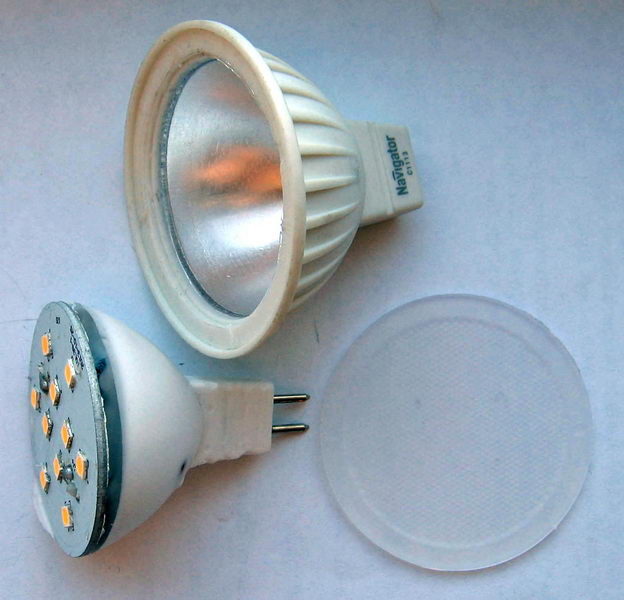
The Navigator NLL-MR16 3K GU5.3 lamp controller is built on a BP2832A microchip [4]. In terms of radio interference, everything is fine, the lamps are "quiet." With pulsations of light, everything is fine too. The least pulsation of the lamp NLL-MR16 3K. The Navigator NLL-PAR16 4K GU10 lamp controller is built on an SL21083 [4] chip from NXT. The NLL-PAR16 4K lamp has slight light pulsations at 86 kHz, but only the infrared control system of the TV will notice them.
If it were not for the absence of a radiator, Navigator lamps would be a good choice.
[ Ecola ]
The lamp Ecola 6w 2800K GU5.3 is equipped with a very high-quality aluminum radiator. Unfortunately, the lamp gives a large level of radio interference and a significant level of light ripples at a frequency of 67.5 kHz, which can degrade the performance of remote control systems for household appliances (see Table 2).
The controller is built on a chip BP3122 [4].
Unfortunately, for the Ecola lamps the manufacturer gives only a year of warranty, which raises doubts about the long life of the lamps.
[ Jazzway ]
These lamps, like BBK, also have a full-fledged aluminum radiator, but it looks simpler. At the 2700K lamp, the radiator has through grooves that improve air circulation, and at the 3000K lamp, the radiator has a large number of fins. GU10 lamp base is made of heat-resistant white plastic. The 3000K lamp has a complex multi-segment emitting LED, with a diameter of 33 mm (this is the largest “LED” of all the lamps in the review). The number of radiating segments of the 3000K lamp could not be determined, as they are hidden by the yellow compound. The lamp 2700K has 17 separate LEDs placed on the same plane.
In terms of radio interference, the 2700K and 3000K lamps differ significantly (see table). The lamp 2700K is “quiet”, and 3000K is “fonite” on all radio bands. This is probably due to the specifics of the controller implementation.
The 2700K lamp gives very strong pulsations of the luminous flux with a frequency of 100 Hz (dips about 85% of the maximum radiation). This is not surprising - there is no controller in the lamp, a simple 12 μF 400V capacitor was used as a current limiter [4]. The 3000K lamp has a full-fledged controller on the LIS8512 chip [4], and the 3000K lamp has so small pulsations of light that it is impossible to estimate them, i.e., this lamp gives a stable, flicker-free light (if only it did not give radio interference 2700K, it would not have been the price).
It is difficult to say which of these two lamps to choose. If you keep your eyes, it is better to take a 3000K lamp, but if you are a radio amateur, then 2700K is better. Keep in mind that the use of a large number of lamps with a damping condenser (like a 2700K lamp) will degrade the mains supply due to a phase shift between current and voltage.
[ Gauss ]
The lamp has a metal radiator, a base made of heat-resistant plastic, looks very dignified. Packaging and instructions are made very high quality, as if it is not a lamp, but a piece of jewelry.
Radio interference on HF is not noticed, there are VHF. There are large pulsations of light at a frequency of 100 Hz.
IMHO lamp is nothing special stands out, except for quality packaging and unreasonably high prices.
[ ASD ]
In appearance and design, the ASD JCDRC 7.5w lamp is absolutely the same as the Jazzway 2700K lamp. The same case, the same aluminum radiator, the same dimensions, the number and arrangement of the emitting LEDs, even the parameters are almost the same, only the color temperature of the light differs. The ASD JCDRC 7.5w and Jazzway 2700K lamps are so similar that they seem to be made on the same conveyor, just the marking is different and different packaging is used.
The level of radio interference and pulsation of the light flux all coincides with the lamp Jazzway 2700K. No radio interference, but the flickering of light is large, at a frequency of 100 Hz. The cause of the ripple is that instead of a controller, a 12 µf 400V capacitor is used as a current limiter.
[ Conclusions ]
1 . When buying lamps you should pay attention to the type of base and length of the lamp, because it affects the ability to install the lamp in the place where it will be used.
2 If you need to connect a lamp with a GU5.3 or GU10 base to a conventional cartridge, then you need to take care of purchasing an adapter (adapter).
Please note that with the adapter, the total length of the lamp will be longer, and it may not fit into the luminaire ceiling. The photo below shows the BBK PC74C lamp installed in the cartridge.
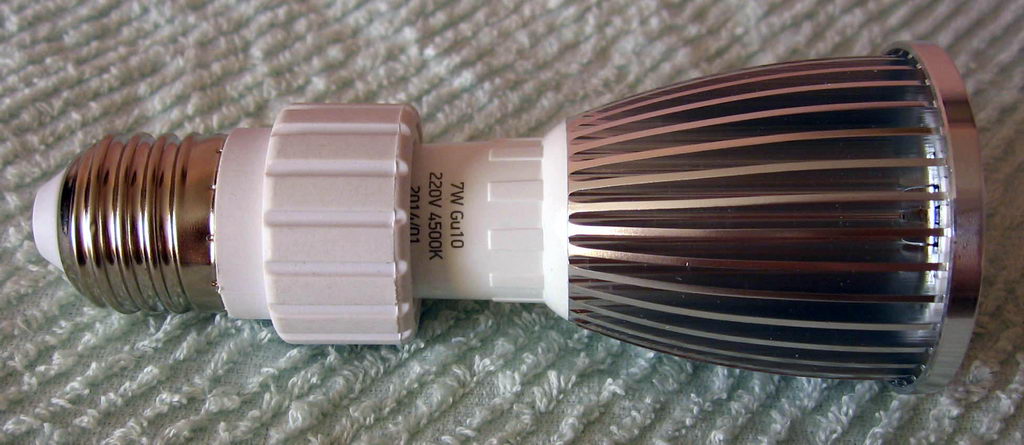
3 If the stated angle of the light beam of the lamp is about 60..70 degrees, then surely it is a lamp with a reflector, with a heap of LEDs, or with a single LED. In my opinion, such a lamp has limited use, because it needs a special light diffuser.If the angle of the light beam is about 120 degrees, then the reflector is absent, the light emit several LEDs, standing at some distance from each other. It is possible that a diffuser of light is also used in such a lamp (a matte translucent cover covering the LEDs).
4Color temperature indicates the color of the lamp. The lower the number of color temperature, the closer the color shifts to yellow, the higher - the closer to white and light blue. For example, 2700..3000K corresponds to a soft yellow light, which is close in spectrum to ordinary incandescent lamps (I like this warm illumination more), and 4000..4500 correspond to white light (as in fluorescent lamps).
5To install the lamp, the GU10 base is the most reliable, it does not require additional mounting of the lamp body (although an additional mount does not hurt). Unlike GU10, the base of GU5.3 does not provide reliable fixing of the lamp. Therefore, without additional fastening, it is impossible to use the lamp with the GU5.3 base; the lamp can simply jump out of the holder.
I did not like the GU5.3 cartridge, despite the fact that it is compact. Contacts GU5.3 are unreliable, and installing a lamp is quite difficult (it is difficult to get pins in the sockets) - if you compare the cartridges of GU5.3 and GU10 adapters. The cartridge GU10, on the contrary, is very convenient, the lamp is easily inserted and removed, held securely in the cartridge.
6Some models of LED lamps can generate strong radio frequency interference. Therefore, if your activity is related to radio reception or accurate laboratory radio measurements, then pay special attention to the choice of lamps and install additional filters.
7If there are no special requirements for the size of the LED lamps and you are not constrained in the means, then give preference to lamps with a metal cooling radiator. The LEDs in them will last longer, because the temperature mode of the LEDs is better, they heat less in the process. If possible, do not use fully enclosed luminaires for LED lamps, where cold air is difficult to supply to the lamp. Try not to buy lamps without an aluminum radiator, especially with a power of 7 W or more.
8 . Be careful with working LED lamps, do not look at their radiating surface. Especially carefully handle the lamps that have reflectors (with a narrow angle of the light beam) - catch the bunnies in the eyes easily!
[ UPD140725 ]
At the request of the workers, he added the color rendering index Ra to Table 1 , which is also CRI [3] (not all of the lamps were able to find this parameter).
[ Links ]
1 . GOST R 54350-2011 - measurement of parameters of LED light sources .
2 LED lamp .
3 Color Rendering Index - Wikipedia .
4 The internal structure of LED lamps - the schematic diagrams, oscillograms of current consumption, luminous flux.
I will not compare LED-lamps with other light sources, just try to compare some LED-lamps among themselves. The review also did not include lamps with built-in dimmers (regulators of the lamp brightness level) and lamps with a standard base, which can be screwed into the cartridge instead of a conventional light bulb (there are also such LED lamps). I wanted to explore some of the parameters of LED lamps on my own - electromagnetic interference and flickering of light (manufacturers do not provide any objective information of this kind). I hope that the review will be useful to those who are thinking about the use of LED lamps at home.
Obviously, the LED light bulbs must generate interference, because each is a pulse controller. The controller operates at frequencies of the order of 50..85 kHz, but due to sharp voltage drops at the key node of the controller, an electromagnetic signal with a wide spectrum is obtained. There is no specific information about the level of interference anywhere. In the instructions for the lamp, you can read abstract phrases such as “The product is certified according to current State Standards”. But what does this really mean? How much do these lamps generate noise, and how different are the different brands of lamps in this parameter? It is impossible to compare different lamps in terms of noise level without special experiments, so I decided to get puzzled by this too.
')
In addition, the LED has a very high speed, i.e. it turns on and off almost instantly. The current feeding the LEDs has pulsations due to the nature of the controller construction. For reasons of the cost of production, the filter for smoothing pulsations cannot be made ideal, therefore the LED-lamp will necessarily flicker. The smaller the pulsation of the luminous flux, and the higher the frequency of the pulsations, the subjectively better the LED lighting will be, the less tired the eyes will be. The intensity of flicker and its nature depends on the implementation of the controller. It also wants to explore.
[ What lamps are involved in the review ]
It was possible to purchase the lamps of the companies Ecola (Russia, Moscow), Navigator (LLC BT-Logistic, Russia, Moscow), BBK (BBK Electronics LTD., China), Jazzway (like a Russian company, but where it is located, could not be determined), Gauss (Russia, Naberezhnye Chelny), ASD (ASD Lighting, United Kingdom). All lamps had bases like GU5.3 and GU10, incompatible with traditional incandescent bases. The photo below shows these caps. The distance between the axes of the pins at the base of GU5.3 is 5.3 mm, for the GU10 it is 10 mm.

[ How was the light level measured ]
I have not had the opportunity to do all the measurements exactly as recommended by the standards [1]. Therefore, I tried to put the lamps in the same conditions: I twisted the tested lamp into a ceiling lamp with a lamp shade and measured the level of illumination at the workplace, where I sit at the computer. Illuminance measured lux meter Lux Meter LX1010BS .
Lux Meter LX1010BS Appearance

118 lux - workplace lighting during the daytime with daylight ceiling lights turned off. 400..1000 lux - a sunny day in the shade, a well-lit workplace. In my tests, the illumination turned out to be about 60..100 lux - I wrapped the test lamp in the upper ceiling lamp and installed a luxmeter some distance from the lamp so that the main direct beam of light did not fall on it.
[ Comparison of lamps in terms of electromagnetic interference ]
I didn’t have a radio frequency spectrum analyzer, so I checked the hearing with the help of the Leningrad-006 radio receiver, on the HF and VHF bands.
Radio 'Leningrad-006'

The radio receiver stood with the whip antenna extended at a distance of 1 meter from the working lamp. Each lamp received a conditional estimate of the interference level from 0 to 10 (0 interference was not detected, 10 is the maximum interference level), and this data was entered in Table 2.
[ How the ripples of the light flux were evaluated ]
As a sensor of the pulsations of light, I used a solar battery from a country luminaire.
Solar battery as a pulsation sensor for luminous flux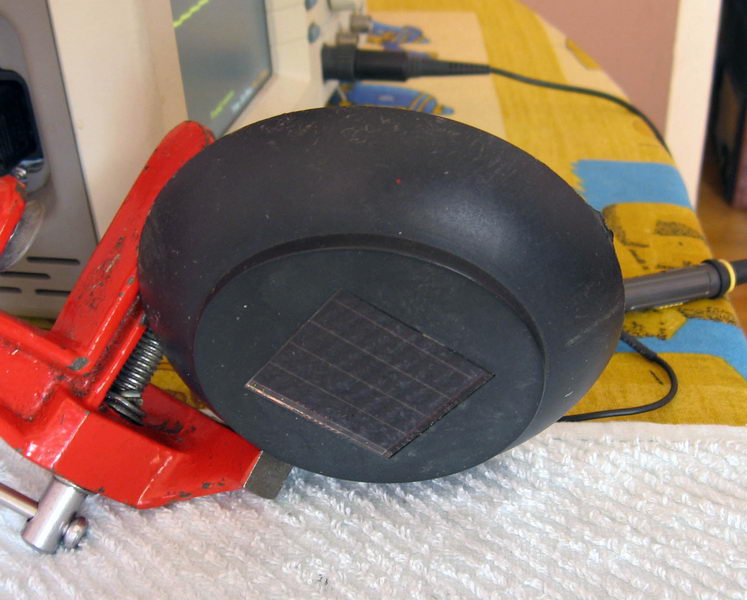

Loaded the battery on a 180 Ohm resistor and connected to the oscilloscope. As it turned out, it turned out to be an excellent light sensor, which confidently showed both low-frequency (100 Hz) and high-frequency pulsations (50..85 kHz). Interestingly, some lamps gave pulsations at a frequency of 100 Hz, and some at high frequencies of 50..85 kHz.
Examples of oscillograms of pulsations of light of LED lamps
Low-frequency ripple light bulb ASD JCDRC 7.5w:
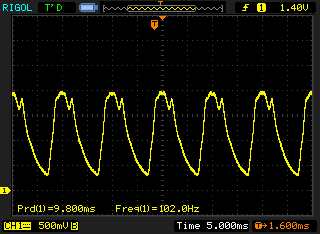
HF ripple light (about 50 kHz) BBK P653F lamps:
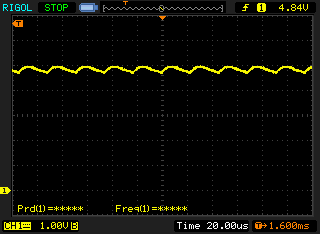

HF ripple light (about 50 kHz) BBK P653F lamps:

You still won't notice the pulsations of 100 Hz, but perhaps this will increase fatigue and you may experience visual beats with the TV screen (many modern TVs also have a screen refresh rate close to 100 Hz). High-frequency pulsations of light can affect the operation of remote control systems for household appliances. In addition, if a room is illuminated by several lamps with large pulsations of light at a high frequency, then due to the difference in the frequencies of the pulsations (the operating frequencies of the controllers are not synchronized with each other), light pulsations can also be seen by eye.
Thus, it is necessary to try to choose lamps with a minimum level of pulsation of the luminous flux, at whatever frequency they are.
[ As I compared the lamps to each other ]
Home laboratory stand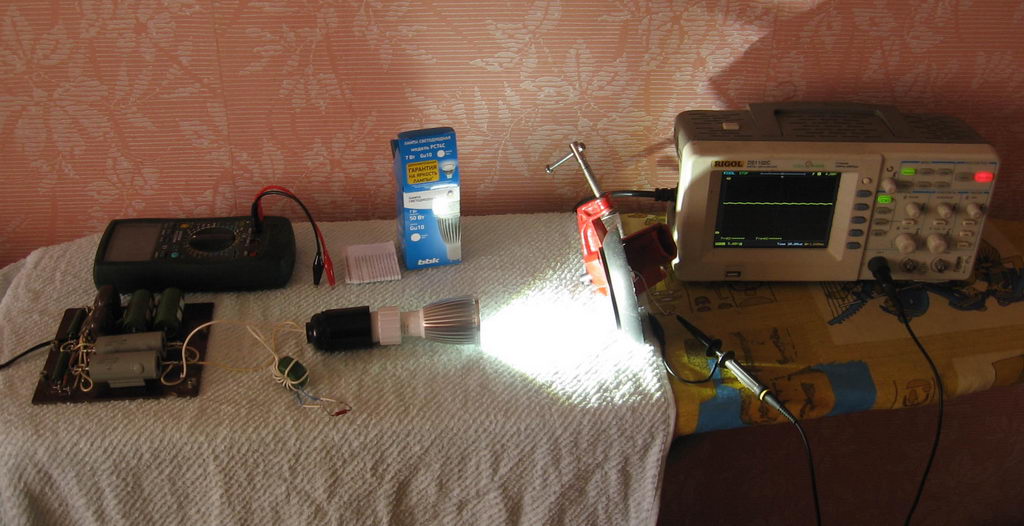
Powered by a lamp just in case served through an industrial surge protector (in the photo on the left). The oscillograms of the input current of the controller were taken using a current transformer from a ferrite ring. The pulsation of the light flux was monitored at the output of a solar battery loaded onto a resistor (in the photo next to the Rigol DS1102C oscilloscope).

Powered by a lamp just in case served through an industrial surge protector (in the photo on the left). The oscillograms of the input current of the controller were taken using a current transformer from a ferrite ring. The pulsation of the light flux was monitored at the output of a solar battery loaded onto a resistor (in the photo next to the Rigol DS1102C oscilloscope).
First, I put into a single table all the official data that I was able to collect about the lamps - the price, power consumption, color temperature and other parameters that can be found on the lamp packaging. This table allows you to make a general preliminary assessment of the lamps. Green highlighted cells in the table, showing the best parameters among the other lamps, orange - bad parameters.
Table 1. Parameters of LED lamps provided by the manufacturer.

The most important parameters that can be distinguished in the table are the price of the lamp, the luminous flux and the power consumption. Their ratio determines how effective the lamp is. I did not take into account the service life, since it cannot be checked, and the actual service life will vary greatly depending on the operating conditions. To estimate the lamp's efficiency, I calculated the conditional efficiency coefficient K:
K = Light / (Price * Pow)
In this formula, Light means luminous flux (Lm, the higher the luminous flux, the brighter the lamp shines), Price is the price (rubles, the cheaper the lamp is, the faster it will pay for itself), Pow is the power consumed by the lamp (W, the smaller the lamp consumes electricity, so it is more profitable). This coefficient K rather conditionally estimates the efficiency of the lamp, because the luminous flux strongly depends on the presence of a reflector (the angle of the light beam), and many other factors are not taken into account (controller efficiency, lamp life, workmanship, etc.).
The second table was compiled on the basis of experimental data. The table includes the measured level of illumination, the level of radio interference, pulsations of the luminous flux and other data. Green highlighted cells in the table, showing the best parameters among the other lamps, orange - bad parameters.
Table 2. Experimentally obtained parameters of LED lamps.

The line “Illumination” shows the illumination in suites, which the lux meter showed at my workplace (the lamp was installed in the ceiling lamp). Of course, for a full-fledged illumination of the whole room, a single 6.7 watt LED lamp is not enough.
The efficiency of the regulator was calculated by the traditional method:
Efficiency,% = 100 * (Pout / Pin)
This formula Pout means the output power delivered by the regulator (the product of the measured current and voltage), and Pin means the power supplied to the regulator input (the product of the measured input current and input voltage). Please note that some of the lamps in the review had a very low controller efficiency - about 40%, which seemed to me very strange. Subsequently, it turned out that for these lamps the “controller” is built according to the simplest scheme - based on a quenching capacitor (for more, see [4]). Not sure what to buy such lamps.
[ BBK ]
I was surprised when I learned about BBK as a lamp maker, because I had to deal with BBK appliances like DVD players or media centers before. 4 BBK lamps, which have fallen into the review, have a high-quality plinth chambered for GU10 in white heat-resistant plastic (looks like ceramic) and an aluminum radiator.
Lamp BBK P653F, photo





Lamp BBK P654F, photo





P653F and P654F lamps have a smaller power and consist of 32 separate LEDs placed on the same plane, at some distance from each other. Therefore, the P653F and P654F lamps produce more diffused light with a beam angle of 120 o .
Lamp BBK PC73C, photo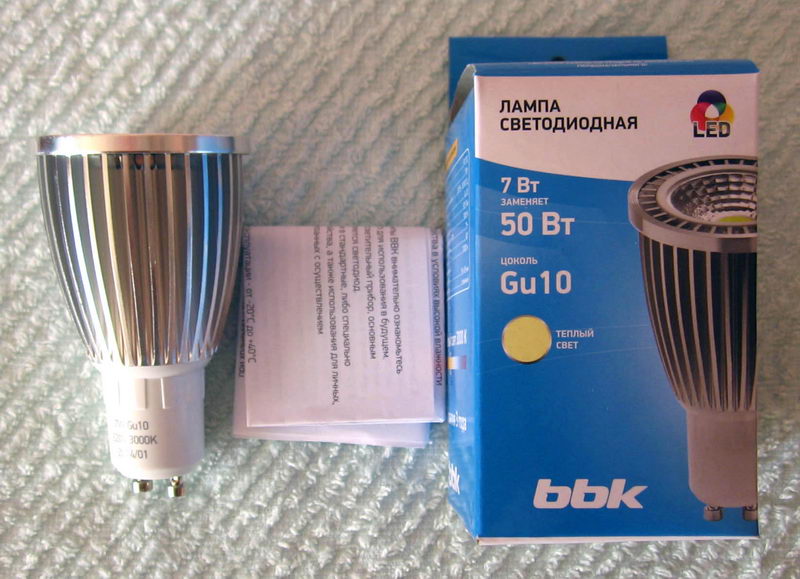

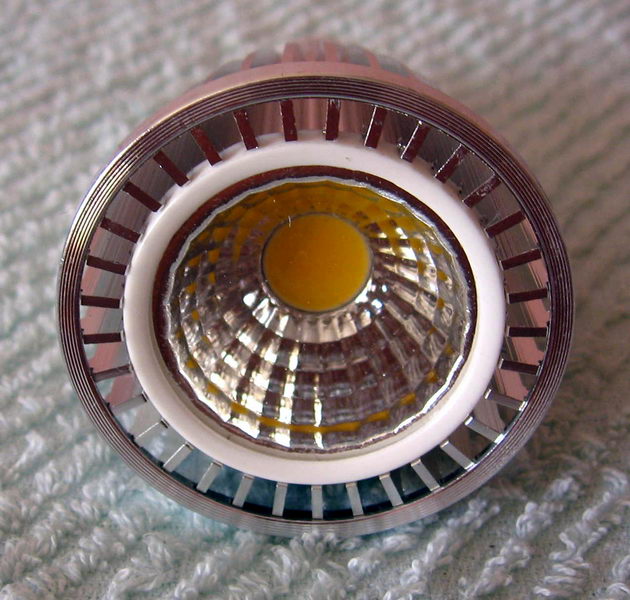



Lamp BBK PC74C, photo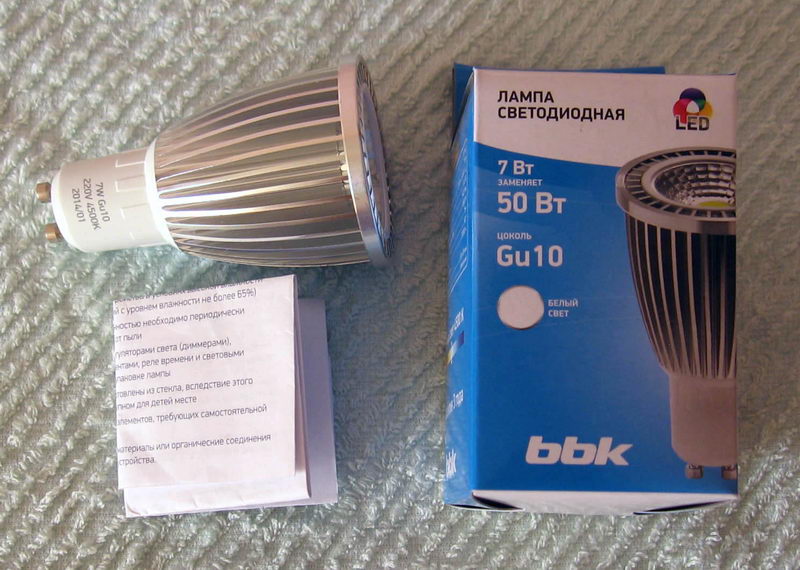

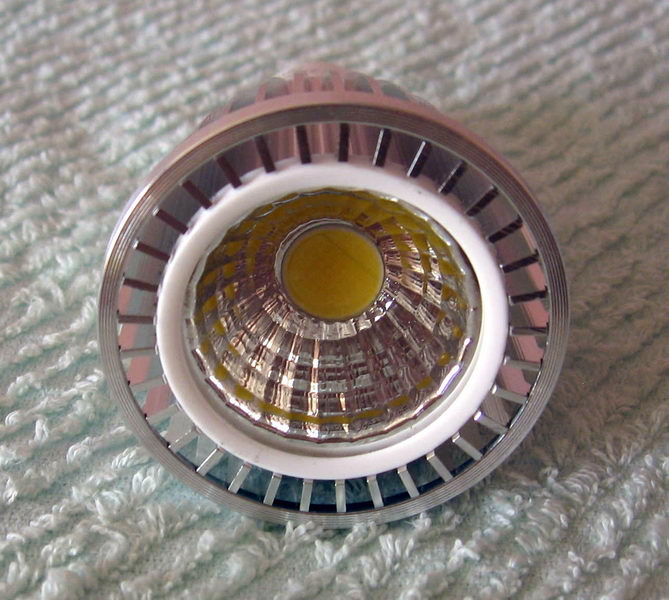



The PC73C and PC74C lamps are equipped with a reflector concentrating light from a complex multi-segment LED (consisting of a 5x7 array of radiating elements), therefore they produce a narrow beam of light with a divergence angle of about 60o. The lamp radiator has a temperature of 45..65 oC.
BBK lamps look the best of all in terms of design and performance. BBK are not the only ones in the review who have an honest aluminum radiator, but BBK has a radiator of the highest quality and has many cooling lobes. The surface of the radiator has traces of processing on a turning and milling machine, and this is quite an expensive operation. I don’t know how the lamps were made, but this affected the consumer price only slightly (see Table 1).
The color temperature of the lamps, as far as I could figure out, depends on the color of the compound, which covers the light-emitting LED elements. The yellower the compound, the lower the color temperature.
The P653F and P654F lamp controllers are based on the SM7525 chip, while on the PC73C and PC74C lamps, based on the BP9023 chip [4]. In terms of radio interference, the PC73C and PC74C lamps did not perform well (see Table 2). P653F and P654F lamps have a small, almost imperceptible level of radio interference. The level of pulsation of the light flux of all BBK lamps is very low (about 8..9%) and lies in the high-frequency, invisible spectrum (about 55 kHz). Of these lamps, I would choose for myself the lamps P653F and P654F. An additional advantage for BBK bulbs - there is an additional guarantee of 3 years on the brightness of the luminous flux, which none of the other brands have.
[ Navigator ]
Lamp Navigator NLL-MR16 3K GU5.3, photo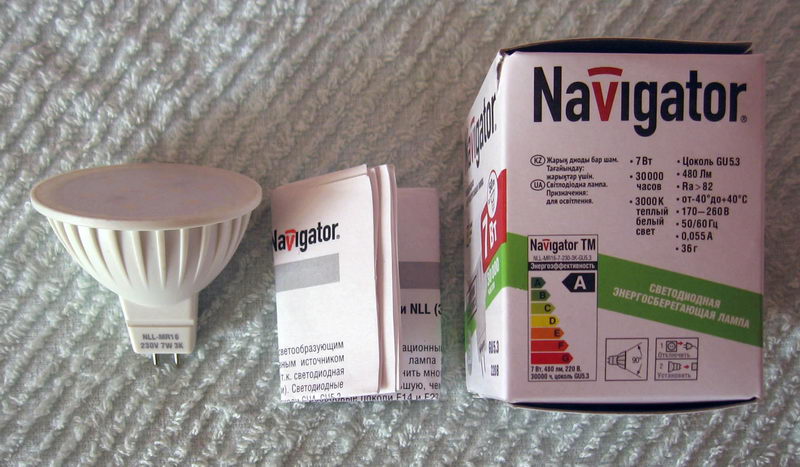





Lamp Navigator NLL-PAR16 4K GU10, photo





The design of the lamps is the cheapest - a molded case of grayish plastic, there is no cooling radiator. The NLL-MR16 3K lamp fell apart right in my hands when I tried to establish contacts in the GU5.3 cartridge.

The Navigator NLL-MR16 3K GU5.3 lamp controller is built on a BP2832A microchip [4]. In terms of radio interference, everything is fine, the lamps are "quiet." With pulsations of light, everything is fine too. The least pulsation of the lamp NLL-MR16 3K. The Navigator NLL-PAR16 4K GU10 lamp controller is built on an SL21083 [4] chip from NXT. The NLL-PAR16 4K lamp has slight light pulsations at 86 kHz, but only the infrared control system of the TV will notice them.
If it were not for the absence of a radiator, Navigator lamps would be a good choice.
[ Ecola ]
The lamp Ecola 6w 2800K GU5.3 is equipped with a very high-quality aluminum radiator. Unfortunately, the lamp gives a large level of radio interference and a significant level of light ripples at a frequency of 67.5 kHz, which can degrade the performance of remote control systems for household appliances (see Table 2).
Ecola 6w 2800K GU5.3 lamp, photo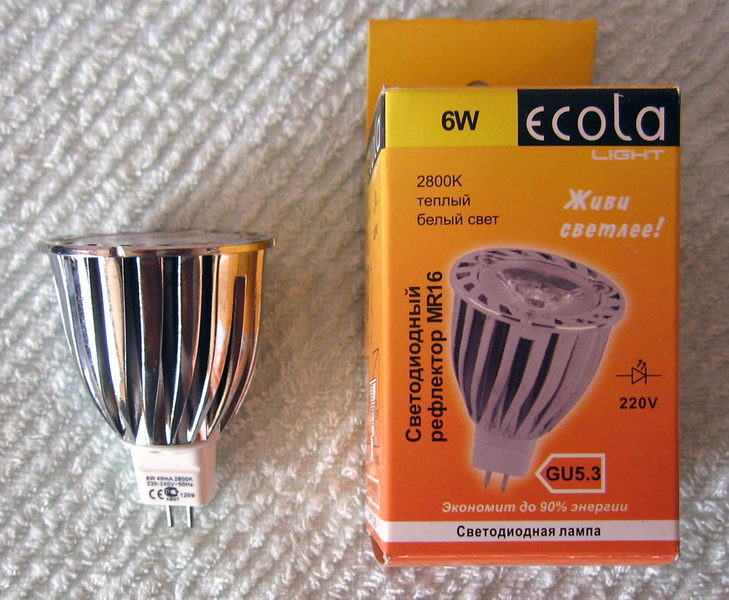
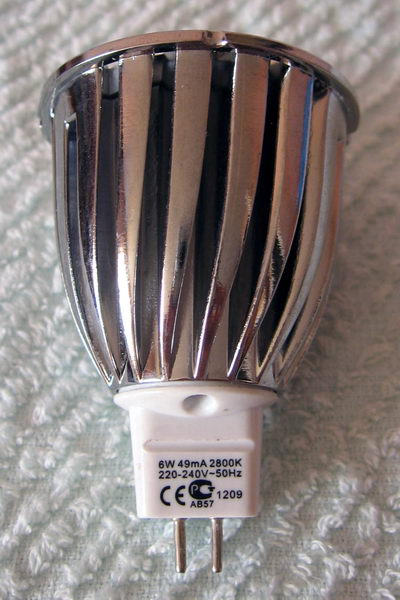
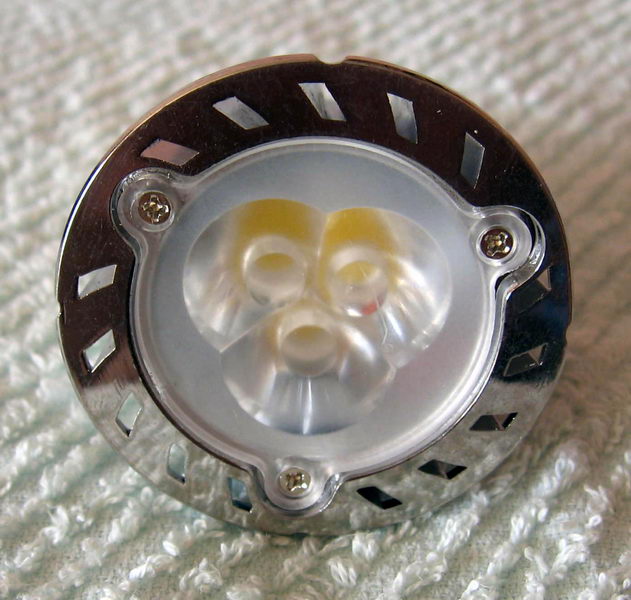



Lamp Ecola 7w 4200K GU10, photo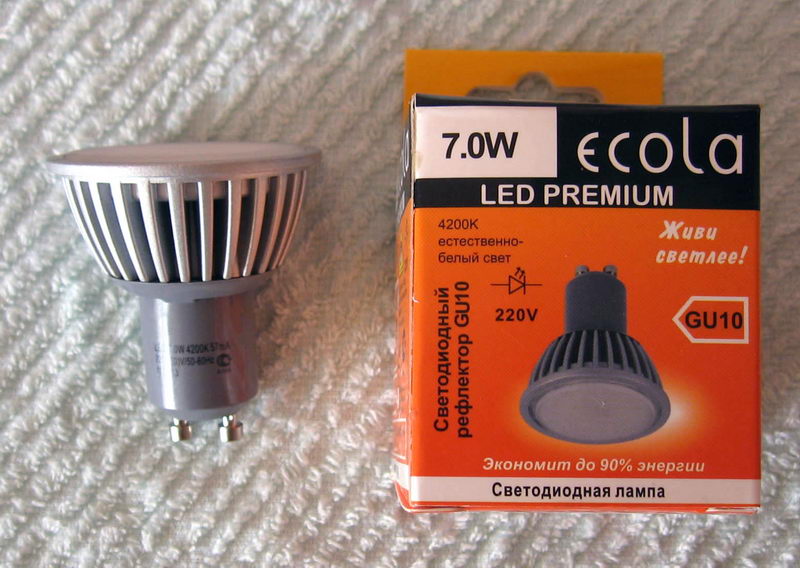
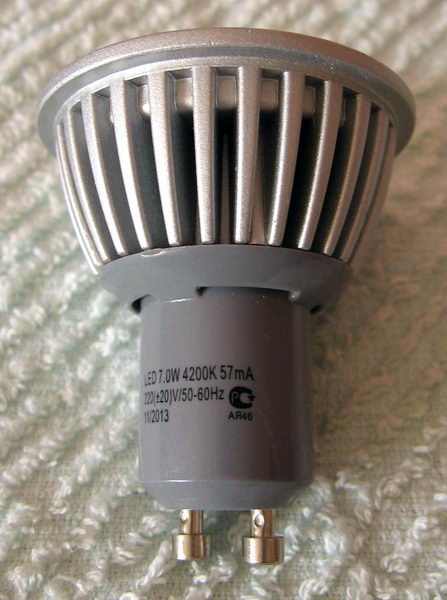




The controller is built on a chip BP3122 [4].
As arranged inside the Ecola 7w 4200K GU10
Under the protective lens hides the printed circuit board with 14 LEDs installed in series. Since the controller produces a voltage of 81 volts for a chain of LEDs, then surely each LED is dual (there are 2 LED elements in series inside each “LED”). The LED board transfers heat to the aluminum radiator through thermal paste.
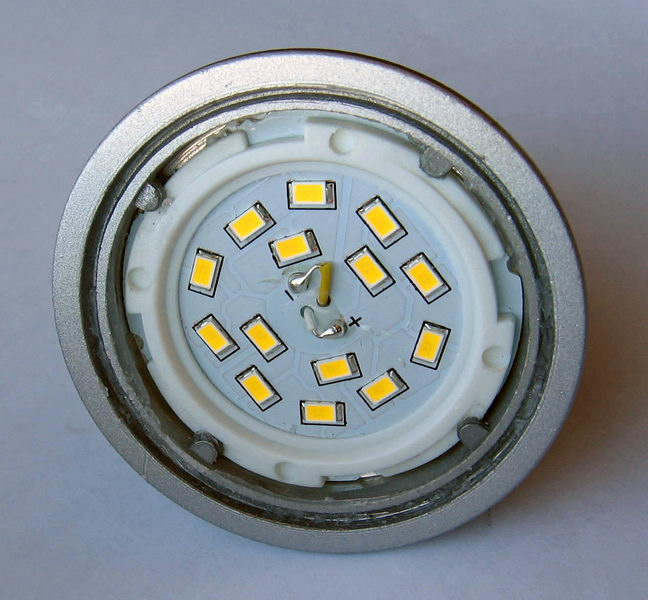
The lamp controller is built on the Chinese chip BP2831A . The concept is surprisingly simple. Resistors RS1 and RS2, connected in parallel, are used to adjust the current through the LEDs.

The controller is placed directly in the base of the lamp, all external conductors of the controller are made as short as possible. It is possible that this is precisely what explains the complete absence of electromagnetic interference?


Below are the oscillograms of the input AC, which comes from the 220 V network.
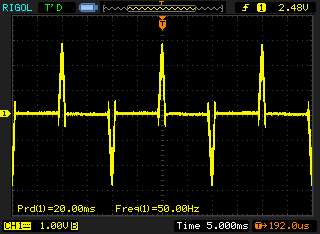
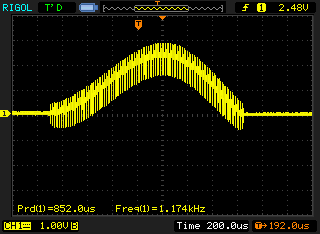

And this is the oscillogram from the output of the solar battery. Absolutely no pulsation of light, neither high-frequency nor low-frequency!
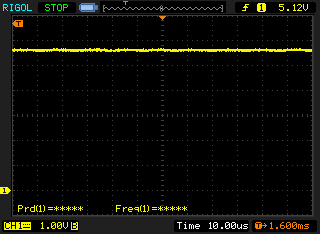

The lamp controller is built on the Chinese chip BP2831A . The concept is surprisingly simple. Resistors RS1 and RS2, connected in parallel, are used to adjust the current through the LEDs.

The controller is placed directly in the base of the lamp, all external conductors of the controller are made as short as possible. It is possible that this is precisely what explains the complete absence of electromagnetic interference?


Below are the oscillograms of the input AC, which comes from the 220 V network.



And this is the oscillogram from the output of the solar battery. Absolutely no pulsation of light, neither high-frequency nor low-frequency!

Unfortunately, for the Ecola lamps the manufacturer gives only a year of warranty, which raises doubts about the long life of the lamps.
[ Jazzway ]
These lamps, like BBK, also have a full-fledged aluminum radiator, but it looks simpler. At the 2700K lamp, the radiator has through grooves that improve air circulation, and at the 3000K lamp, the radiator has a large number of fins. GU10 lamp base is made of heat-resistant white plastic. The 3000K lamp has a complex multi-segment emitting LED, with a diameter of 33 mm (this is the largest “LED” of all the lamps in the review). The number of radiating segments of the 3000K lamp could not be determined, as they are hidden by the yellow compound. The lamp 2700K has 17 separate LEDs placed on the same plane.
Lamp Jazzway 7.5w 2700K GU10, photo
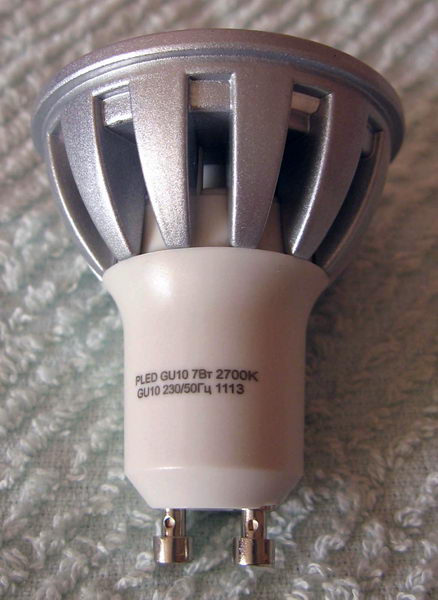
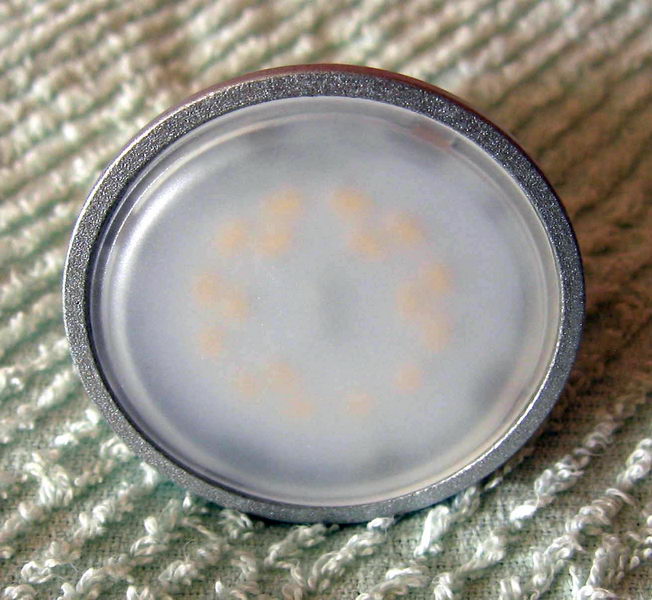



Lamp Jazzway 7.5w 3000K GU10, photo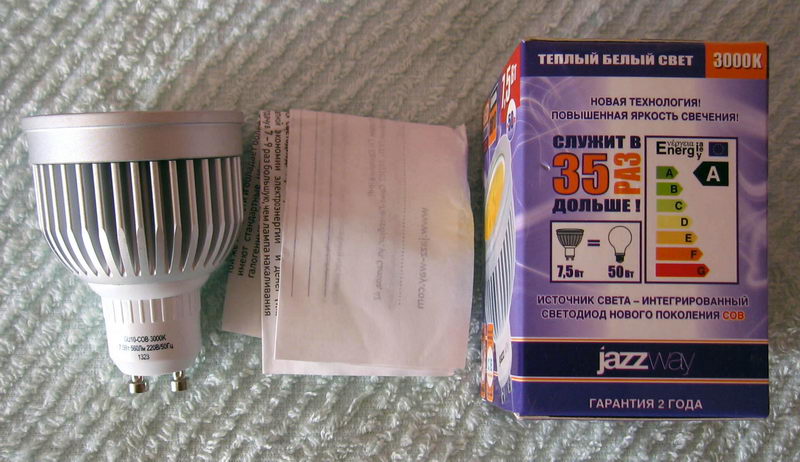
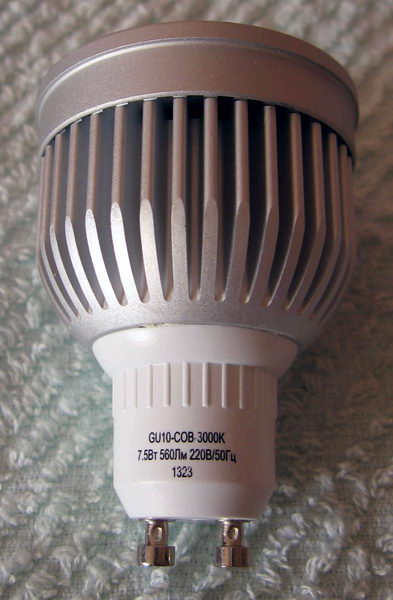
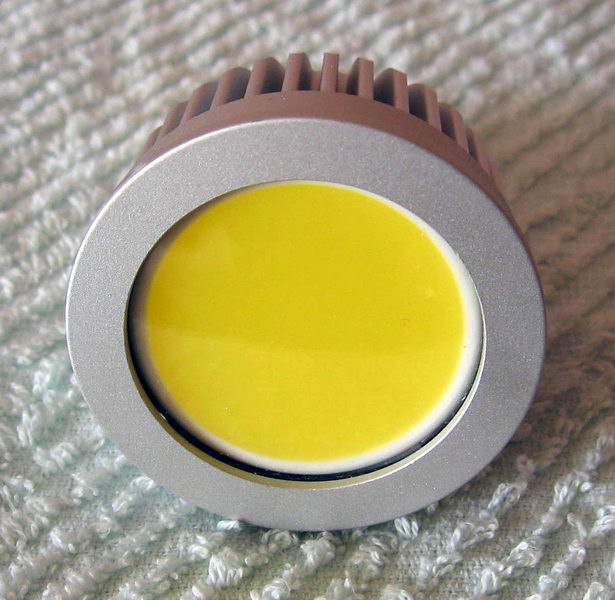



In terms of radio interference, the 2700K and 3000K lamps differ significantly (see table). The lamp 2700K is “quiet”, and 3000K is “fonite” on all radio bands. This is probably due to the specifics of the controller implementation.
The 2700K lamp gives very strong pulsations of the luminous flux with a frequency of 100 Hz (dips about 85% of the maximum radiation). This is not surprising - there is no controller in the lamp, a simple 12 μF 400V capacitor was used as a current limiter [4]. The 3000K lamp has a full-fledged controller on the LIS8512 chip [4], and the 3000K lamp has so small pulsations of light that it is impossible to estimate them, i.e., this lamp gives a stable, flicker-free light (if only it did not give radio interference 2700K, it would not have been the price).
It is difficult to say which of these two lamps to choose. If you keep your eyes, it is better to take a 3000K lamp, but if you are a radio amateur, then 2700K is better. Keep in mind that the use of a large number of lamps with a damping condenser (like a 2700K lamp) will degrade the mains supply due to a phase shift between current and voltage.
[ Gauss ]
The lamp has a metal radiator, a base made of heat-resistant plastic, looks very dignified. Packaging and instructions are made very high quality, as if it is not a lamp, but a piece of jewelry.
Gauss lamp EB101106107 photo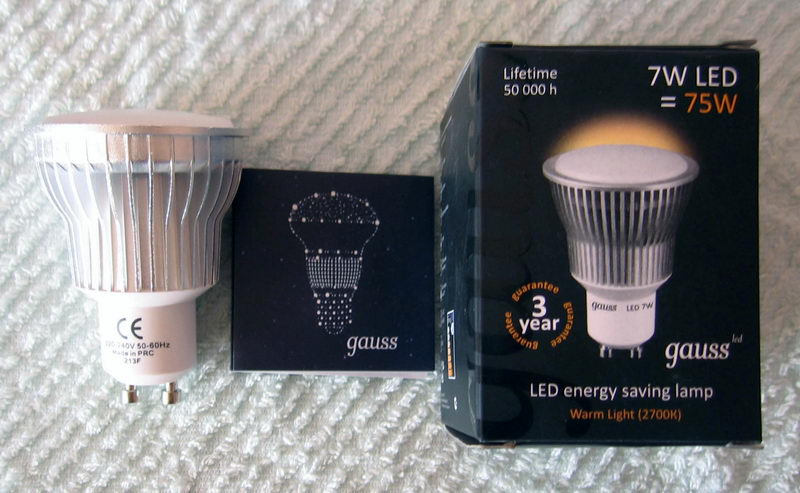
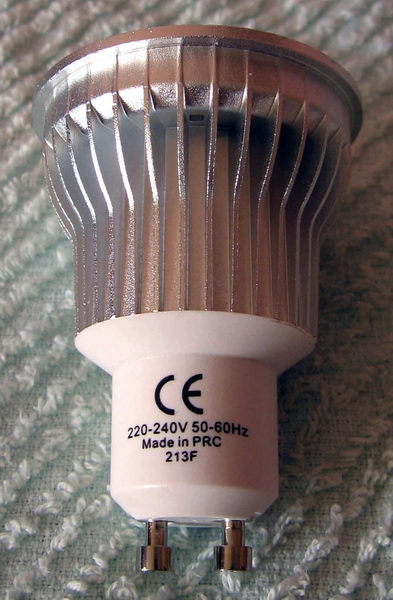




Radio interference on HF is not noticed, there are VHF. There are large pulsations of light at a frequency of 100 Hz.
IMHO lamp is nothing special stands out, except for quality packaging and unreasonably high prices.
[ ASD ]
In appearance and design, the ASD JCDRC 7.5w lamp is absolutely the same as the Jazzway 2700K lamp. The same case, the same aluminum radiator, the same dimensions, the number and arrangement of the emitting LEDs, even the parameters are almost the same, only the color temperature of the light differs. The ASD JCDRC 7.5w and Jazzway 2700K lamps are so similar that they seem to be made on the same conveyor, just the marking is different and different packaging is used.
Lamp ASD JCDRC 7.5w, photo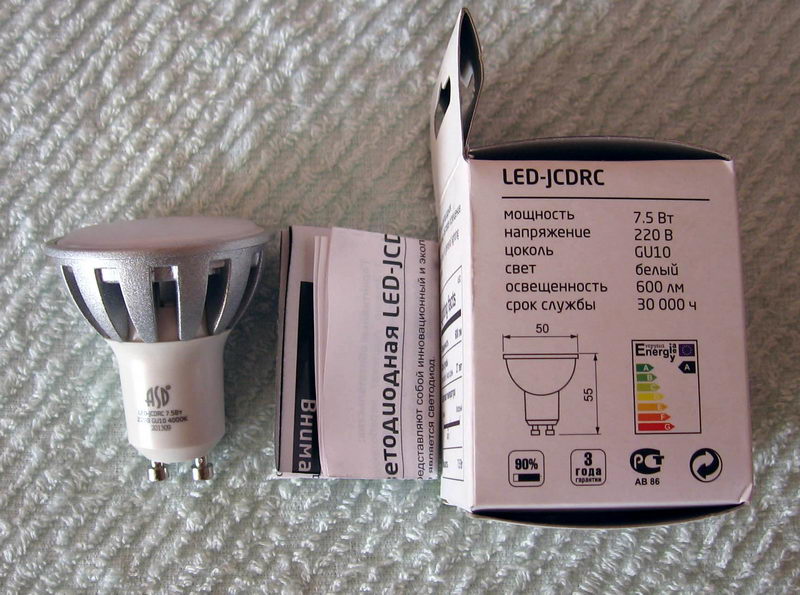





The level of radio interference and pulsation of the light flux all coincides with the lamp Jazzway 2700K. No radio interference, but the flickering of light is large, at a frequency of 100 Hz. The cause of the ripple is that instead of a controller, a 12 µf 400V capacitor is used as a current limiter.
[ Conclusions ]
1 . When buying lamps you should pay attention to the type of base and length of the lamp, because it affects the ability to install the lamp in the place where it will be used.
2 If you need to connect a lamp with a GU5.3 or GU10 base to a conventional cartridge, then you need to take care of purchasing an adapter (adapter).
What are the adapters GU5.3 and GU10
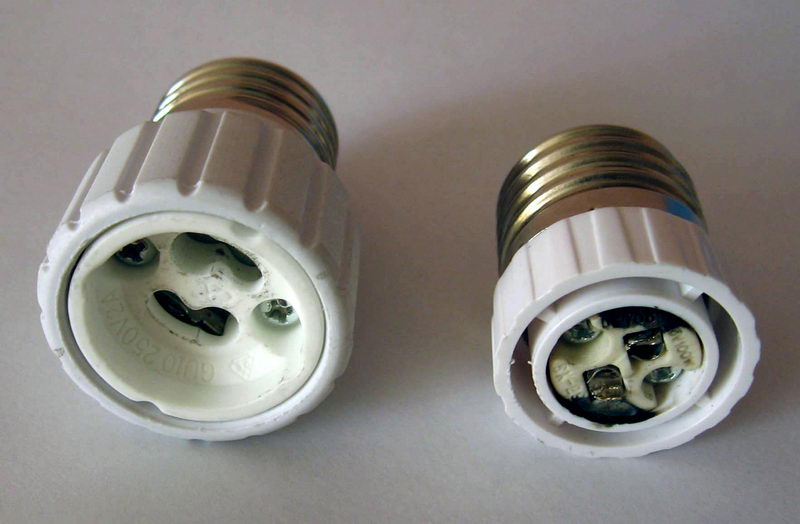


Please note that with the adapter, the total length of the lamp will be longer, and it may not fit into the luminaire ceiling. The photo below shows the BBK PC74C lamp installed in the cartridge.

3 If the stated angle of the light beam of the lamp is about 60..70 degrees, then surely it is a lamp with a reflector, with a heap of LEDs, or with a single LED. In my opinion, such a lamp has limited use, because it needs a special light diffuser.If the angle of the light beam is about 120 degrees, then the reflector is absent, the light emit several LEDs, standing at some distance from each other. It is possible that a diffuser of light is also used in such a lamp (a matte translucent cover covering the LEDs).
4Color temperature indicates the color of the lamp. The lower the number of color temperature, the closer the color shifts to yellow, the higher - the closer to white and light blue. For example, 2700..3000K corresponds to a soft yellow light, which is close in spectrum to ordinary incandescent lamps (I like this warm illumination more), and 4000..4500 correspond to white light (as in fluorescent lamps).
5To install the lamp, the GU10 base is the most reliable, it does not require additional mounting of the lamp body (although an additional mount does not hurt). Unlike GU10, the base of GU5.3 does not provide reliable fixing of the lamp. Therefore, without additional fastening, it is impossible to use the lamp with the GU5.3 base; the lamp can simply jump out of the holder.
I did not like the GU5.3 cartridge, despite the fact that it is compact. Contacts GU5.3 are unreliable, and installing a lamp is quite difficult (it is difficult to get pins in the sockets) - if you compare the cartridges of GU5.3 and GU10 adapters. The cartridge GU10, on the contrary, is very convenient, the lamp is easily inserted and removed, held securely in the cartridge.
6Some models of LED lamps can generate strong radio frequency interference. Therefore, if your activity is related to radio reception or accurate laboratory radio measurements, then pay special attention to the choice of lamps and install additional filters.
7If there are no special requirements for the size of the LED lamps and you are not constrained in the means, then give preference to lamps with a metal cooling radiator. The LEDs in them will last longer, because the temperature mode of the LEDs is better, they heat less in the process. If possible, do not use fully enclosed luminaires for LED lamps, where cold air is difficult to supply to the lamp. Try not to buy lamps without an aluminum radiator, especially with a power of 7 W or more.
8 . Be careful with working LED lamps, do not look at their radiating surface. Especially carefully handle the lamps that have reflectors (with a narrow angle of the light beam) - catch the bunnies in the eyes easily!
[ UPD140725 ]
At the request of the workers, he added the color rendering index Ra to Table 1 , which is also CRI [3] (not all of the lamps were able to find this parameter).
[ Links ]
1 . GOST R 54350-2011 - measurement of parameters of LED light sources .
2 LED lamp .
3 Color Rendering Index - Wikipedia .
4 The internal structure of LED lamps - the schematic diagrams, oscillograms of current consumption, luminous flux.
Source: https://habr.com/ru/post/230913/
All Articles